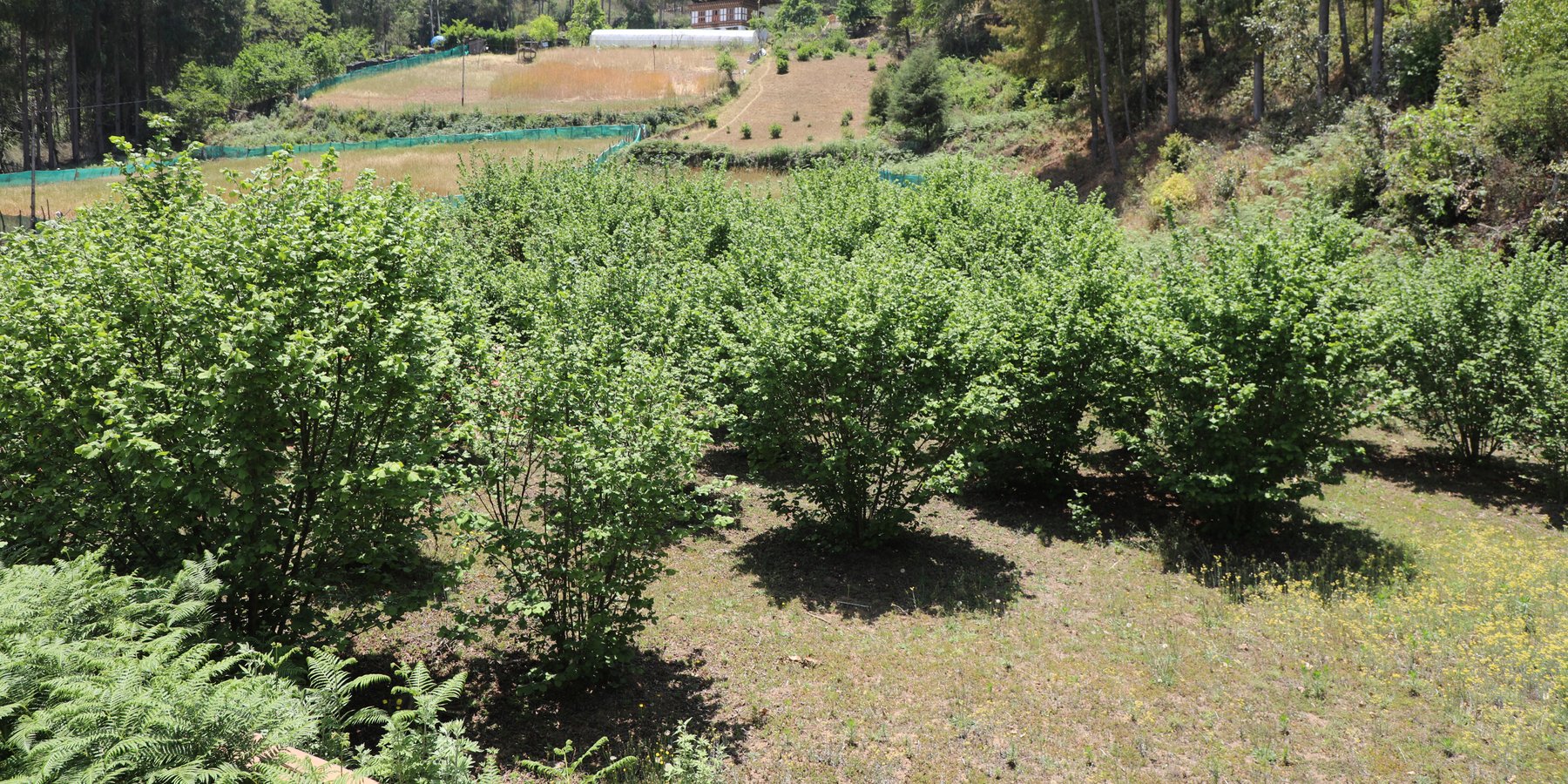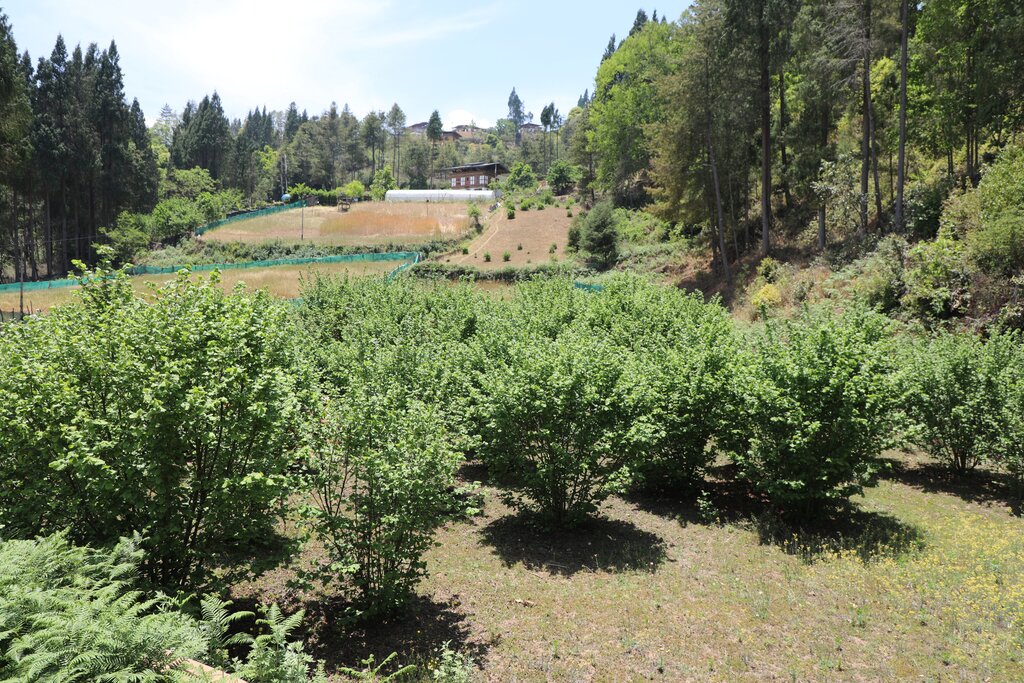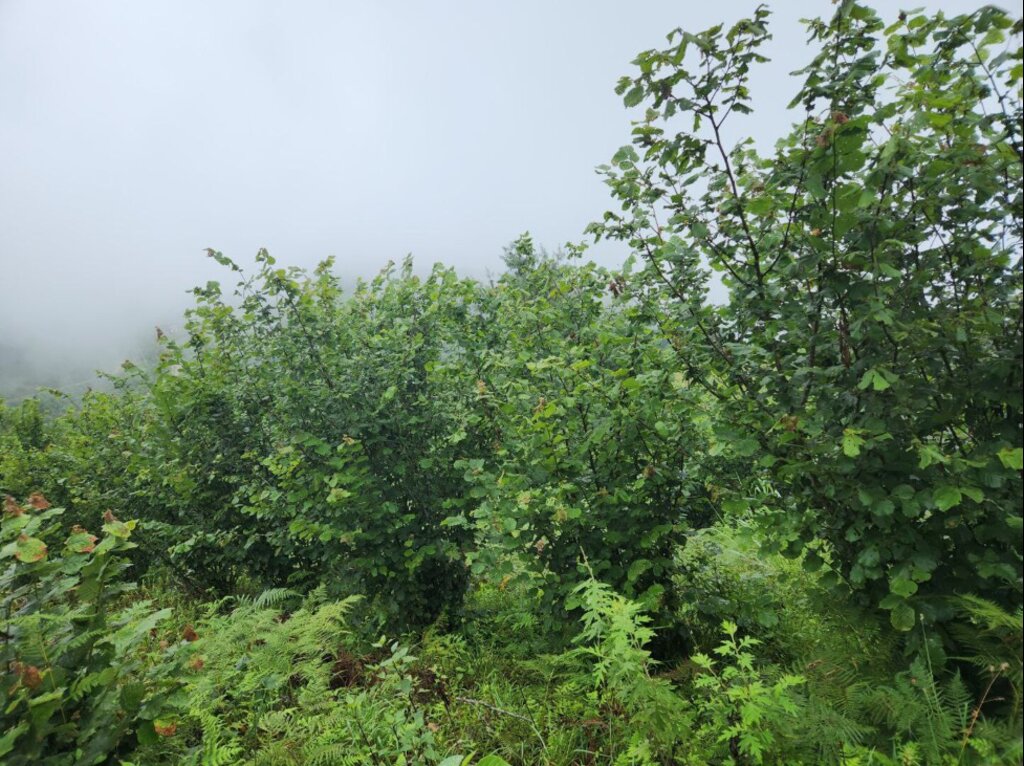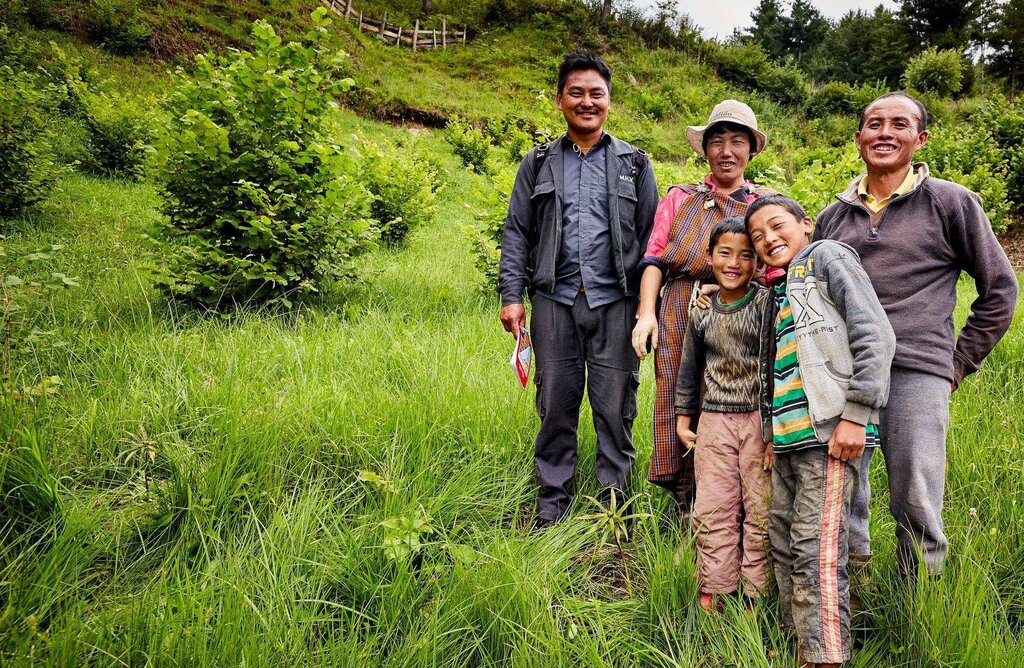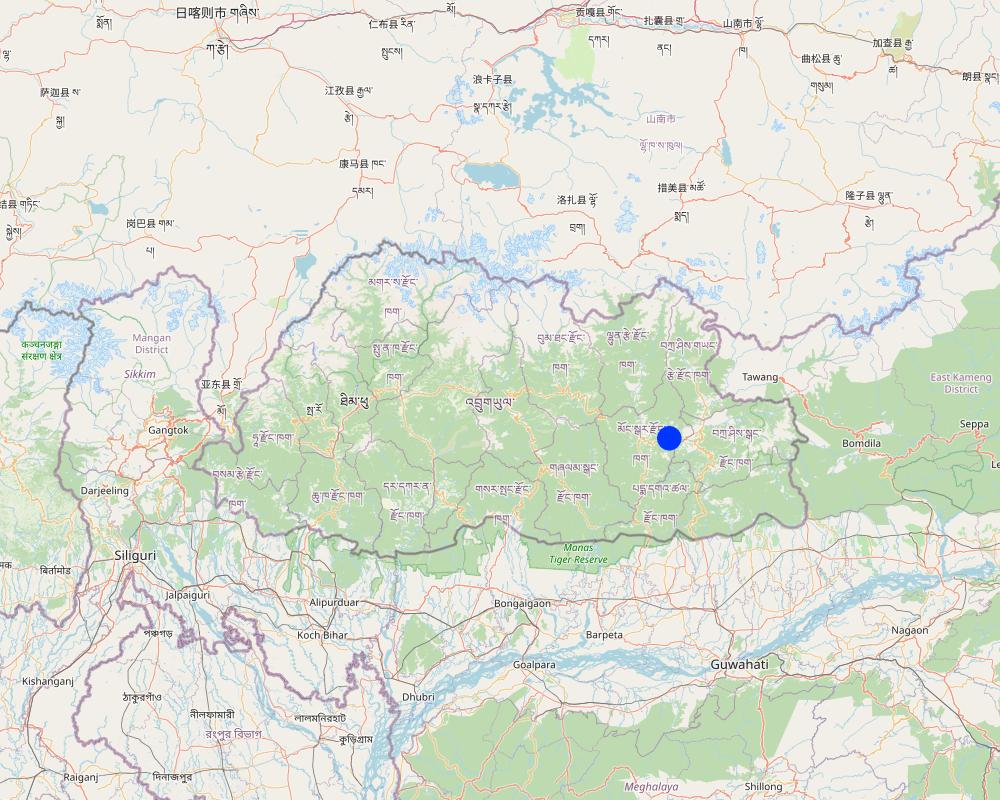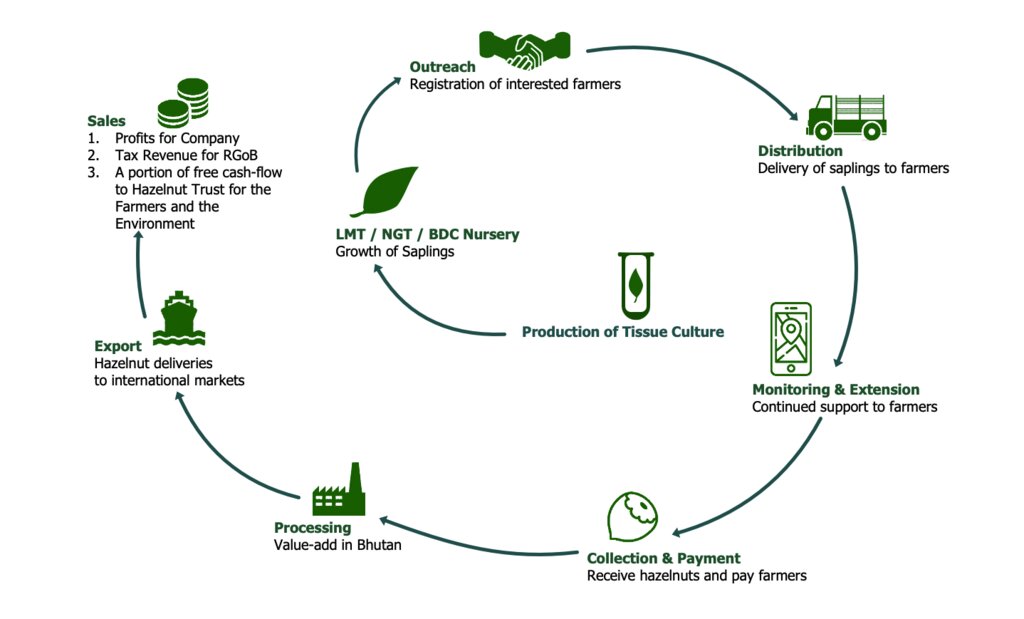Public-Private-Community Partnership for Land Degradation Neutrality [Bután]
- Creación:
- Actualización:
- Compilador: ONGPO LEPCHA
- Editor: Kuenzang Nima
- Revisores: William Critchley, Rima Mekdaschi Studer, Joana Eichenberger
Zhung Ger dang Midhey Thuendrel Thok Sazhi Dhakzin Thabthang (གཞུང་ སྒེར་དང་མི་སྡེ་མཐུན་འབྲེལ་ཐོག་ས་གཞི་བདག་འཛིན་འཐབ་ཐངས།)
approaches_6843 - Bután
Visualizar secciones
Expandir todo Colapsar todos1. Información general
1.2 Detalles de contacto de las personas de referencia e instituciones involucradas en la evaluación y la documentación del Enfoque
Persona(s) de referencia clave/s
Usuario de la tierra:
Tenzin Karma
+975 77675442
Domlung village
Domlung village, Ngatshang gewog (block), Mongar Dzongkhag (district), Bhutan
Bután
Usuario de la tierra:
Penjor Tshewang
+97517544223
Domlung village
Domlung village, Ngatshang gewog (block), Mongar Dzongkhag (district), Bhutan
Bután
Usuario de la tierra:
Wangmo Yeshey
+97517680522
Domlung village
Domlung village, Ngatshang gewog (block), Mongar Dzongkhag (district), Bhutan
Bután
Usuario de la tierra:
Lhamo Ngawang
Domlung village
Domlung village, Ngatshang gewog (block), Mongar Dzongkhag (district), Bhutan
Bután
Nombre del proyecto que facilitó la documentación/ evaluación del Enfoque (si fuera relevante)
Strengthening national-level institutional and professional capacities of country Parties towards enhanced UNCCD monitoring and reporting – GEF 7 EA Umbrella II (GEF 7 UNCCD Enabling Activities_Umbrella II)1.3 Condiciones referidas al uso de datos documentados mediante WOCAT
¿Cuándo se compilaron los datos (en el campo)?
13/07/2023
El compilador y la/s persona(s) de referencia claves aceptan las condiciones acerca del uso de los datos documentados mediante WOCAT :
Sí
2. Descripción del Enfoque MST
2.1 Breve descripción del Enfoque
The public-private-community partnerships (PPCP) approach is a synergistically operational model that is used to achieve sustainable development in which the three parties jointly develop a business unit/service of mutual benefit and provide maximum benefit to the wider community. This approach is designed to enable economically disabled households and community organizations to generate long-term benefits through sustainable agriculture - in this case hazelnut production.
2.2 Descripción detallada del Enfoque MST
Descripción detallada del Enfoque MST:
The Mountain Hazelnut Venture (MHV) is a social enterprise established as a Public-Private-Community Partnership (PPCP) between the people and the Royal Government of Bhutan and a private company. The PPCP approach involves private entity funding of a project, and it has become common countrywide, The MHV has enabled a large-scale Foreign Direct Investment (FDI) project. The MHV provides hazelnut trees, agricultural inputs, and technical assistance to smallholder farmers. At harvest, the company purchases hazelnuts from partner growers, which are then processed for international export. The primary objective of this approach is to foster collaboration between the private company and the community to generate long-term income and revitalize vulnerable communities through sustainable agriculture. Hazelnut orchards stabilize mountain slopes, reduce soil erosion, improve water retention, and help adapt to, and mitigate, climate change by improving ground cover, retaining soil moisture and sequestering carbon.
The private company looks for interested farmers who are then registered. The company propagates good quality hazelnut seedlings and distributes them. This is followed up by constant monitoring by technical staff until fruits are harvested and processed. The implementation stage includes planning, providing them with necessary agricultural inputs, and technical support through extension and monitoring. Once the fruits are harvested, payment is made to the farmers. Implementation involves the MHV engaging with community members alongside agricultural extension agents to present and convince them about the benefits of the project. Additionally, the MHV provides training, workshops, and ongoing support. They finance the project while also taking on the role of monitoring and evaluating its outcomes.
There are three key stakeholders involved in this approach. They are the community members (landowners), the Royal Government of Bhutan, and the Mountain Hazelnut company. It is reported that there are more than 8,000 smallholder land users registered with MHV from 19 of 20 districts in Bhutan. The roles of the land users are to grow hazelnuts through nurturing the seedlings, harvesting the nuts, and selling them to the Hazelnut company as per the mutual agreement. Land users are provided free seedlings, consistent technical and field support, and the guaranteed buyback of nuts by the company. They also received training and assistance. The second key stakeholder is the Royal Government, who provides clearance and facilitates the establishment of business in line with the national Foreign Direct Investment (FDI) Policy. In the field, agriculture extension agents represent the government by facilitating communication between the hazelnut company and the communities. Lastly, the MHV as a private company is committed to fostering the development of entrepreneurs in the agribusiness sector across Bhutan.
The advantages of the approach to the land users are the financial, technical and material support provided by the private company. The land users can also develop their skills and knowledge through training on hazelnut cultivation and good agricultural practices (GAP). Hazelnut is a new crop in the locality.
Finally, the company is committed to generating income and improving the livelihood of rural communities in Bhutan. However, despite the noble objectives, the company has failed to realize its intended target, and this is an increasing cause of concern. Furthermore, there are complaints that the harvests have been poor – or even zero in some cases. It is clear that there had been inadequate investigation into the viability of hazelnuts in Bhutan. While failing on the economic front so far, from the land degradation neutrality (LDN) point of view, the hazelnut plantations have improved ground cover immensely thereby generating environmental benefits through stabilization of vulnerable agricultural land, reduction in land degradation and carbon sequestration.
2.3 Fotos del Enfoque
2.5 País/ región/ lugares donde el Enfoque fue aplicado
País:
Bután
Región/ Estado/ Provincia:
Mongar Dzongkhag
Especifique más el lugar :
Domlung village, Ngatshang gewog
Map
×2.6 Fechas de inicio y conclusión del Enfoque
Indique año del inicio:
2011
Comentarios:
The approach is currently in the monitoring and evaluation phase since the Hazelnut trees in Domlung village have not fruited even once as like most other orchards in the country.
2.7 Tipo de Enfoque
- proyecto/ basado en un programa
2.8 Propósitos/ objetivos principales del Enfoque
The primary objective of this approach is to persuade the community to embrace the Mountain Hazelnut Venture and foster collaboration between the private company and the community to advance the project, generate long-term income, revitalise vulnerable communities through sustainable agriculture, stabilising mountain slopes, reducing erosion, improving water retention, and mitigating climate change by improving soil fertility and carbon sequestration.
2.9 Condiciones que facilitan o impiden la implementación de la/s Tecnología/s aplicadas bajo el Enfoque
normas y valores sociales/ culturales/ religiosos
- facilitan
Because land users are from same ethnic group, they shared similar culture and traditional. There were no objection from other land users on implementing the technology.
disponibilidad/ acceso a recursos y servicios financieros
- facilitan
The project is fully funded by a private company, meaning the company provides all the planting materials and inputs with regard to it; very minimal cost goes into the project by the land users.
colaboración/ coordinación de actores
- facilitan
Officials from the private company often visit the community to monitor and evaluate the progress of the project, and has played a significant role in providing the community members with all the skills and knowledge with regard to hazelnut cultivation.
conocimiento de MST, acceso a apoyo técnico
- facilitan
The land users were trained on good agricultural practices (GAP) for hazelnut cultivation and proper land management practices before implementing the project.
mercados (para comprar insumos, vender productos) y precios
- impiden
Despite the guaranteed buyback by the company, the land users could not harvets any hazelnuts as there is no fruiting yet.
carga de trabajo, disponibilidad de mano de obra
- facilitan
Hazelnuts are fairly easy to grow and not much care is required. Hence not much of labour is required.
3. Participación y roles de las partes interesadas involucradas
3.1 Partes interesadas involucradas en el Enfoque y sus roles
- usuarios locales de tierras/ comunidades locales
Domlung community members (land users)
The roles of the Interested land users are to grow hazelnut saplings on their land, nurture these seedlings, harvest the nuts, and sell them to the Hazelnut company.
- sector privado
Mountain Hazelnut Venture
It is committed to fostering the development of entrepreneurs in the agribusiness sector across Bhutan. It provides farmers with seedlings, and agricultural inputs such as fertilizers and extension services, and also buys the nuts from the land users. Apart from this Mountain Hazelnuts is committed to fostering the development of entrepreneurs in the agribusiness sector across Bhutan.
- gobierno nacional (planificadores, autoridades)
Ministry of Agriculture and Livestock of the Royal Government of Bhutan
Provided clearance and facilitaed business establishment as per the Foreign Direct Investment (FDI) Policy.
- Extension agent
Ngatshang gewog (block) Agriculture Extension Agent
Facilitated communication between the private company and the communities.
3.2 Involucramiento de los usuarios locales de tierras/ comunidades locales en las distintas fases del Enfoque
| Involucramiento de los usuarios locales de tierras/ comunidades locales | Especifique quién se involucró y describa las actividades | |
|---|---|---|
| iniciación/ motivación | interactivo | The land users were sensitized on the Mountain Hazelnut Venture, in particular the long term benefits of improving income and livelihoods. Mutual agreements were signed between the company and the land users. |
| planificación | pasivo | The private company (MHV) decide on the timeline of the project and how to implement it. However, the community members and the extension agents are informed about the plan. |
| implementación | auto-movilización | For the implementation, land users were equipped with all the skills and materials required for the projects success. They plant and cultivate the hazelnut in their fields on their own, with some assistance from the company's field coordinator. |
| monitoreo y evaluación | interactivo | Officials from the company (MHV) visits the land users field together with the land users, where the hazelnuts were cultivated and checks the progress of the project. |
3.3 Flujograma (si estuviera disponible)
Descripción:
The flow chart of the approach was adopted from Mountain Hazelnut Venture (MHV) website
Autor:
Mountain Hazelnut Venture website (https://www.mountainhazelnuts.com/)
3.4 La toma de decisiones en la selección de Tecnología(s) MST
Las decisiones para la selección de la/s Tecnología(s) fueron tomadas:
- Private sector (MHV)
Explique:
The decision to implement the project in Domlung was done by the private company (MHV) based on their findings and agreement by the community.
Especifique las bases que sustentaron la toma de decisiones:
- la evaluación de conocimiento MST bien documentado (la toma de decisiones se basa en evidencia)
4. Apoyo técnico, fortalecimiento institucional y gestión del conocimiento
4.1 Construcción de capacidades / capacitación
¿Se proporcionó la capacitación a usuarios de tierras/ otras partes interesadas?
Sí
Especifique quién fue capacitado:
- usuarios de tierras
Forma de capacitación:
- de agricultor a agricultor
- áreas de demostración
- reuniones públicas
Temas avanzados:
The subjects covered included the cultivation of hazelnuts, good agricultural practices, proper land and agronomic management of hazelnuts, grafting, weed control, and sustainable land management.
Comentarios:
The capacity building was financed by the private company and was supervised by the agricultural extension agent.
4.2 Servicio de asesoría
¿Los usuarios de tierras tienen acceso a un servicio de asesoría?
Sí
Especifique si servicio proporcionado se realizó:
- en los campos de los usuarios de tierras
- Private company
Describa/ comentarios:
Advisory services were provided by the field coordinator and other officials from the private company (MHV).
4.3 Fortalecimiento institucional (desarrollo institucional)
¿Se establecieron o fortalecieron instituciones mediante el Enfoque?
- no
4.4 Monitoreo y evaluación
¿El monitoreo y la evaluación forman parte del Enfoque?
Sí
Comentarios:
In accordance with the land users of Domlung, officials from the private company visits the village sporadically to check the progress of the project.
Si respondió que sí, ¿la documentación se utilizará para monitoreo y evaluación?
No
4.5 Investigación
¿La investigación formó parte del Enfoque?
No
5. Financiamiento y apoyo material externo
5.1 Presupuesto anual para el componente MST del Enfoque
Indique el presupuesto anual para el componente del MST del Enfoque (en US$):
30000000,00
Comentarios (ej. fuentes principales de financiamiento/ donantes principales):
Mountain Hazelnut Venture (The annual budget is the total investment of the company for the entire project)
5.2 Apoyo financiero/material proporcionado a los usuarios de tierras
¿Los usuarios de tierras recibieron financiamiento/ apoyo material para implementar la Tecnología/ Tecnologías? :
Sí
Si respondió sí, especifique el tipo o los tipos de apoyo, condiciones y proveedor(es) :
The financial support was received in the form of planting materials and other materials such as fencing.
5.3 Subsidios para insumos específicos (incluyendo mano de obra)
- equipo
| Especifique qué insumos se subsidiaron | En qué grado | Especifique los subsidios |
|---|---|---|
| Nets | totalmente financiado | Green nets |
- agrícola
| Especifique qué insumos se subsidiaron | En qué grado | Especifique los subsidios |
|---|---|---|
| semillas | totalmente financiado | Hazelnut saplings were provided to the land users for free of cost. |
| fertilizantes | parcialmente financiado | Fertilizers are bought at 50% of its original price by the land users. |
Si la mano de obra de usuarios de tierras fue un insumo sustancial, ¿fue:
- recompensado con otro tipo de apoyo material?
5.4 Crédito
¿Se proporcionó crédito bajo el Enfoque para actividades MST?
No
5.5 Otros incentivos o instrumentos
¿Se usaron otros incentivos o instrumentos para promover la implementación de Tecnologías MST?
No
6. Análisis de impacto y comentarios de conclusión
6.1 Impactos del Enfoque
¿El Enfoque ayudó a los usuarios de tierras a implementar y mantener Tecnologías MST?
- No
- Sí, un poco
- Sí, moderadamente
- Sí, mucho
Almost all the farming households in Domlung have cultivated hazelnuts. They were trained on how to manage land and they also reported the benefits of growing trees besides harvesting the nuts.
¿El Enfoque movilizó/mejoró el acceso a recursos financieros para implementar MST?
- No
- Sí, un poco
- Sí, moderadamente
- Sí, mucho
There was no improvement in access to financial resources, but the land users have been supported financially for the project through provisin of inputs either free or on cost sharing basis.
¿El Enfoque mejoró el conocimiento y capacidades de los usuarios para implementar MST?
- No
- Sí, un poco
- Sí, moderadamente
- Sí, mucho
All the land users in Domlung village have attended several trainings and workshops before the project implementation. Some of this training included SLM intervention topics like Terrace making, stone bund walls, and growing hazelnuts in erosion-prone areas.
¿El Enfoque construyó/ fortaleció instituciones, colaboración entre partes interesadas?
- No
- Sí, un poco
- Sí, moderadamente
- Sí, mucho
The approach involves three main stakeholders i.e., land users, extension officers of the Royal Government and the private company. The approach has strengthened collaboration between stakeholders, i.e., land users and extension, extension and private company, etc.
¿El Enfoque empoderó a grupos en desventaja social y económica?
- No
- Sí, un poco
- Sí, moderadamente
- Sí, mucho
All the land users were engaged as stakeholders and were equally benefited.
¿El Enfoque mejoró la equidad de género y empoderó a las mujeres y niñas?
- No
- Sí, un poco
- Sí, moderadamente
- Sí, mucho
The approach allowed both men and women to participate. Thus gender equality was well taken care. It is also one of the company's objectives to ensure that women comprise approximately half of MH staff at all levels, from community lead growers through the executive team.
¿El Enfoque alentó a jóvenes/ la siguiente generación de usuarios de tierras a involucrarse con MST?
- No
- Sí, un poco
- Sí, moderadamente
- Sí, mucho
Young land users of the community were the ones who showed more interest to the project.
¿El Enfoque resultó en mejor seguridad alimentaria/ mejoró la nutrición?
- No
- Sí, un poco
- Sí, moderadamente
- Sí, mucho
Although the land was cleared for planting hazelnuts, there were problems with pollination and variety resulting no fruiting. As a result land users turned hopeless without any income.
¿El Enfoque mejoró el acceso a los mercados?
- No
- Sí, un poco
- Sí, moderadamente
- Sí, mucho
Access to the market was assured through the project. However, there was no nut production.
¿El Enfoque mejoró la capacidad de los usuarios de tierras a adaptarse a los cambios climáticos/ extemos y mitigar desastres relacionados al clima?
- No
- Sí, un poco
- Sí, moderadamente
- Sí, mucho
Hazelnut plantation improved ground cover thereby enabling carbon sequestration and soil organic matter.
¿El Enfoque llevó a oportunidades de empleo, ingresos?
- No
- Sí, un poco
- Sí, moderadamente
- Sí, mucho
Individuals from outside the community were able to work for the private company in the last few years.
Contribution ot Land Degradation Neutrality (LDN):
- No
- Sí, un poco
- Sí, moderadamente
- Sí, mucho
Although the MHV project failed to fully realize its main economic objective of income generation, the hazelnut plantation did improve ground cover and helped avoid, reduce and restore degraded land. It thus contributed towards achieveing voluntary Land Degradation Target (LDN) target set by the Royal Government of Bhutan.
6.2 Motivación principal del usuario de la tierra para implementar MST
- producción incrementada
The main motivation was to increase the production by growing hazelnut in marginal land. However, due to pollination and variety issues there was no production.
- incremento de la renta(bilidad), proporción mejorada de costo-beneficio
With assured market, the company's main objective was to enable sustainable source of income for farmer and increase profitability. Even during the implementation process most of the costs were borne by the project thus giving less financial burden to the land users.
- reducción de la degradación de la tierra
Although the land users did not see direct relation between hazelnut plantation and land degradation, after the training provided by the company, they did realize that the hazelnut plantation can help reduce land degradation through improved ground cover.
- carga de trabajo reducida
Hazelnuts are hardy plants (adaptable) and fairly easy to grow and manage as compared to other economic crops like vegetables and cereals. This gives some leisure time to the land users.
- conocimiento y capacidades mejorados de MST
Before Hazelnuts plantation, land remained barren and exposed to different factors of land degradation. However, with hazelnut plantation, the lands are covered from direct sun and rain thereby preventing land degradation. Many land users shared that they didn't have this idea/knowledge before.
6.3 Sostenibilidad de las actividades del Enfoque
¿Pueden los usuarios de tierras sostener lo que se implementó mediante el Enfoque (sin apoyo externo)?
- no
Si respondió no o incierto, especifique y comente:
The land users who agreed to grow hazelnuts were the ones who were economically disabled. They could have sustained what was implemented through the approach if everything had gone as planned. However, there has been almost zero production of the hazelnuts from almost all hazelnut growing areas which has seriously affected the income. It has been almost 12 years since the first implementation of the project. Land users mentioned that they are now looking for other alternatives so that they can uproot hazelnuts and replace them with some other productive crop.
6.4 Fortalezas/ ventajas del Enfoque
| Fuerzas/ ventajas/ oportunidades desde la perspectiva del usuario de la tierra |
|---|
| Support from the company: Easy for the land users to implement the project due to material and technical supports from the approach. Land users received inputs like hazelnut seedlings at the beginning, which was for free. They also received support for growing the seedlings, Taking care of the seedlings, etc., |
| Assured market: Land users also mentioned that the main motivation to get involved in such an approach was the market and the possibility of generating income. The company was willing to buy whatever quantity of hazelnuts they could produce from their land. |
| Capacity development: In addition to the support (agricultural inputs), the land users also received various training through which they were exposed to other technologies which some of them were totally unaware. They could enhance their skills and knowledge on hazelnut production like orchard cultivation, hazelnut value-chain, including processing and the provision of goods and services. |
| Fuerzas/ ventajas/ oportunidades desde la perspectiva del compilador o de otra persona de referencia clave |
|---|
| Opportunities to economically disabled land users: One of the primary objectives of Mountain Hazelnut Venture is to enable smallholder farming households to generate long-term income, revitalize vulnerable communities through sustainable agriculture. Through this approach many youths were given employment as a worker in the project sites. |
| Focus on sustainable land management: The approach made land uesres to grow hazelnuts sapling in their marginal or unproductive land. When hazelnuts is fully grown, hazelnut plantations stabilize mountain slopes, reduce soil erosion, improve water retention, and mitigate climate change by improving soil fertility and carbon sequestration. In brief, hazelnut plantation as a SLM intervention, contributes to the realization of the land degradation neutrality (LDN) target and adapt to and mitigate climate change. |
6.5 Debilidades/ desventajas del Enfoque y formas de sobreponerse a ellos
| Debilidades/ desventajas/ riesgos desde la perspectiva del usuario de la tierra | ¿Cómo sobreponerse a ellas? |
|---|---|
| No transparency of the information: Land users shared that they were lured by some officals saying the approach to be very profitable. They didn't explained them very well on positive and negative long term impact of the project. They didnt know about the plant (hazelnuts), Its problem in fruiting, etc., | This type of project is maily implemented for the welfare of the community. It should never be implemented for sole benefit of the company. |
| Debilidades/ desventajas/ riesgos desde la perspectiva del compilador o de otra persona de referencia clave | ¿Cómo sobreponerse a ellas? |
|---|---|
| No proper planning and research: The main reason why this hazelnut planations failed in many places in Bhutan could be due to lack of proper planning and research. Given the wide range of elevation and climatic conditions in Bhutan, more adaptability or suitability trials at different elevations could have been conducted. | Suitability trials of different varieties of hazelnuts could have been done so that the best performing varieties and management practices could have been promoted to the land users on large scale. |
| No risk management: It appears like the MHV initiated its business with full confidnce that the project will do well in Bhutan and as such no risk management plans were in place. For instance, land users sacrificed most of their land with the hope of generating good income, but this didn't happen in reality. Many land users were left devasted and hopeless without any compensation from the company. | Any project should account the risk and accordingly provision risk management plan in the proposal and agreement. Such provisions should also be made transparent to all the parties so that it becomes very clear about the compensation should the project fail. |
7. Referencias y vínculos
7.1 Métodos/ fuentes de información
- visitas de campo, encuestas de campo
One household
- entrevistas con usuarios de tierras
Four individuals
7.2 Referencias a publicaciones disponibles
Título, autor, año, ISBN:
Asian Development Bank. (n.d.). Public-Private Partnership Handbook. ADB.
¿Dónde se halla disponible? ¿Costo?
https://www.adb.org/sites/default/files/institutional-document/31484/public-private-partnership.pdf
Título, autor, año, ISBN:
Perez, M. C. (2015). Public-Private-Community-Partnerships for Renewable Energy Cooperatives. Wegeningen UR.
¿Dónde se halla disponible? ¿Costo?
https://edepot.wur.nl/337095
7.3 Vínculos a la información relevante disponible en línea
Título/ descripción:
Mountain Hazelnut Venture
URL:
https://www.mountainhazelnuts.com/
Título/ descripción:
Public–Private–Community Partnership
URL:
https://penabulufoundation.org/en/public-private-community-partnership/
Vínculos y módulos
Expandir todo Colapsar todosVínculos
No hay vínculos
Módulos
No se hallaron módulos


